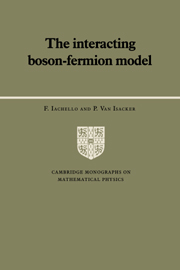7 - Operators
Published online by Cambridge University Press: 07 October 2009
Summary
Introduction
The interacting boson-fermion model-1 describes properties of odd-even nuclei by coupling collective and single-particle degrees of freedom much in the same way this is done in the collective model (Bohr and Mottelson, 1975). The collective degrees of freedom are described either by shape variables αμ (μ = 0, ±1, ±2) or by boson operators s, dμ (μ = 0, ±1, ±2), with no direct link to the underlying microscopic structure. A microscopic description of nuclei is provided by the spherical shell model. Collective features in this model can be obtained by introducing the concept of correlated pairs with angular momentum and parity Jp = 0+ and Jp = 2+. A treatment of these pairs as bosons leads to the interacting boson model. However, since there are protons and neutrons, one has the possibility of forming proton and neutron pairs. In heavy nuclei, the neutron excess prevents the formation of correlated proton-neutron pairs and one thus is led to consider only proton-proton and neutron-neutron pairs. The corresponding model is the interacting boson model-2 (Arima et al., 1977; Otsuka et al., 1978). The introduction of fermions in this models leads to the interacting boson-fermion model-2. In addition to a more direct connection with the spherical shell model, the interacting boson-fermion model-2 has features that cannot be obtained in the interacting boson-fermion model-1.
The structure of model-2 is very similar to that of model-1.
- Type
- Chapter
- Information
- The Interacting Boson-Fermion Model , pp. 221 - 232Publisher: Cambridge University PressPrint publication year: 1991

